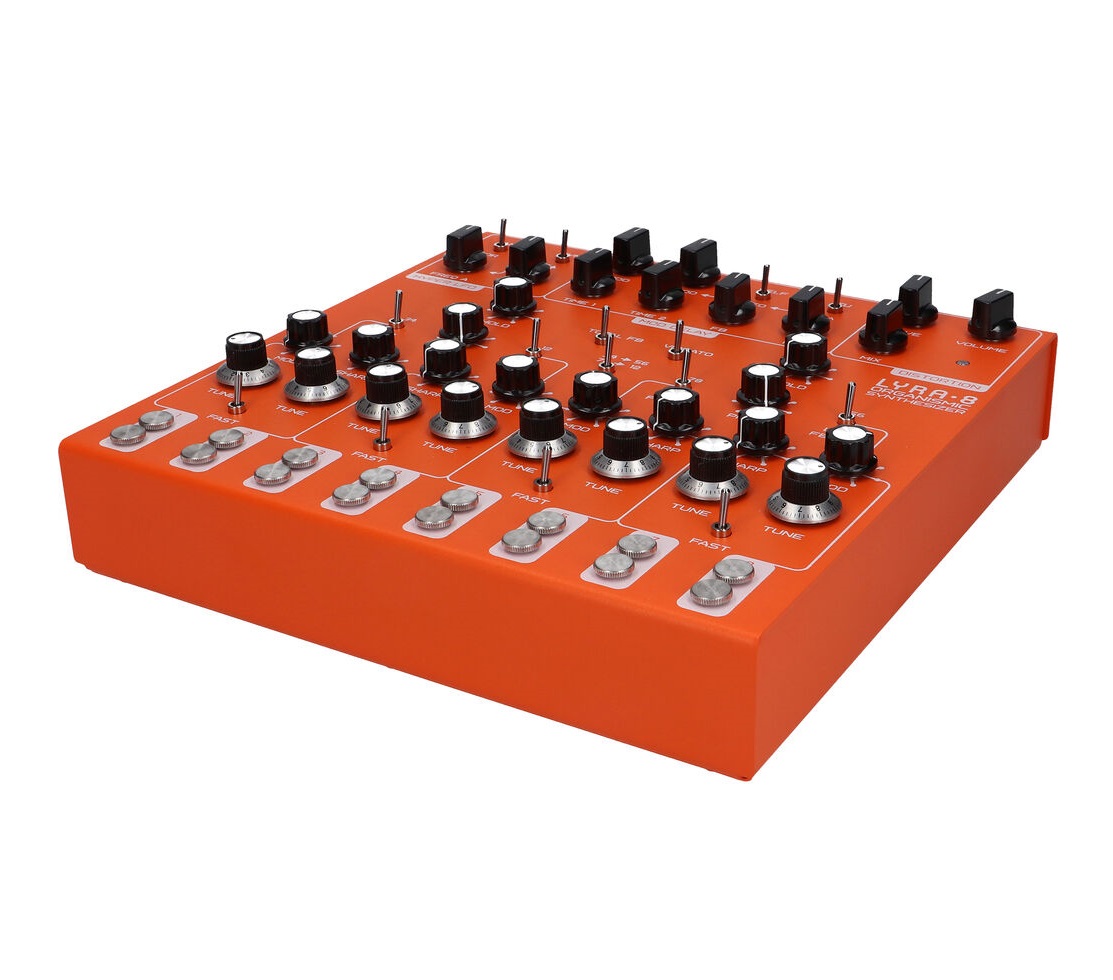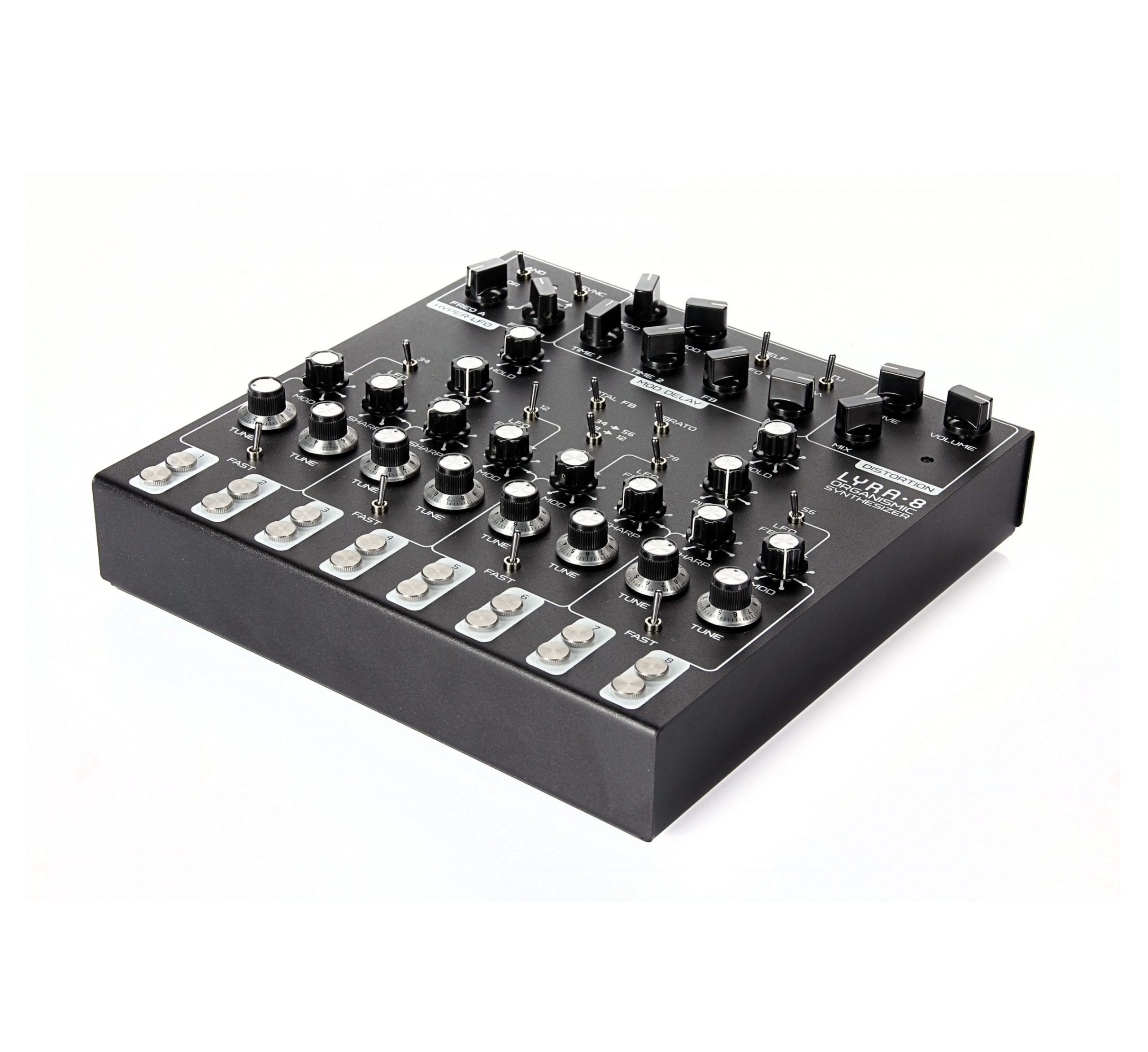Soma Laboratory Lyra-8
Electronic Instruments
Europe
Between 1901 and present
Video
The Soma Laboratory Lyra-8 is a unique analog synthesizer known for its organic sound production and experimental capabilities. It is often referred to as a “mystical analog organism” due to its distinct approach to synthesis. Designed for drone, ambient, and experimental music, the Lyra-8 has carved a niche among musicians and sound designers seeking unconventional sonic textures.
The Lyra-8 is an analog synthesizer that focuses on experimental sound creation. Unlike traditional synthesizers, it does not rely on a keyboard with standard tuning but instead utilizes touch-sensitive metal pads that control the oscillators. It has a raw, evolving, and unpredictable sound, making it a favorite among musicians looking for organic textures and experimental tones. The instrument features eight voices, each with its own tuning and modulation controls, creating deep, evolving soundscapes.
Type of Instrument: The Lyra-8 falls under the category of electronic synthesizers, specifically a drone synthesizer. Unlike conventional synths designed for tonal melodies and structured compositions, drone synthesizers are used for creating sustained, textured soundscapes. The Lyra-8 is purely analog, meaning its sound generation is based on analog circuitry rather than digital signal processing (DSP).
History
The Lyra-8 was developed by Vlad Kreimer, a Russian musician and engineer, and was introduced to the world through his company, Soma Laboratory. The instrument was initially conceptualized as a personal tool for meditation and sonic exploration but evolved into a commercially available synthesizer due to growing interest in its unique sound. It was first released in the 2010s.
The Lyra-8 was created in Europe, specifically in Russia, in the 21st century. Unlike many synthesizers originating from the United States or Japan, the Lyra-8 represents a distinctive approach to electronic music from Eastern Europe, integrating philosophical and artistic concepts into its design.
Construction
The Lyra-8 features a rugged metal chassis, giving it a durable and industrial appearance. It has an unconventional layout with eight touch-sensitive metal pads, multiple knobs for sound shaping, and a set of modulation controls. The lack of a traditional keyboard contributes to its expressive and unpredictable nature.
Internal Components
The core of the Lyra-8 consists of:
- Eight analog oscillators that can be tuned and modulated independently.
- FM modulation capabilities for creating complex harmonic interactions.
- Distortion and delay effects built directly into the unit.
- Modulation inputs for external control and integration with other synthesizers.
- A feedback system that allows for organic and evolving soundscapes.
Types of Lyra Synthesizers
Although the Lyra-8 is the primary model, Soma Laboratory has introduced different versions and related instruments inspired by its design:
- Lyra-4: A smaller version with fewer oscillators, designed for simpler drone textures.
Other Soma Laboratory Synths: While not direct variations, instruments like the Pulsar-23 (a drum machine) share the same experimental ethos.
Characteristics
Unique Features
The Lyra-8’s main distinguishing characteristics include:
Eight independent voices, each controlled by touch.
Non-traditional tuning, allowing for microtonal and organic interactions.
Built-in effects, such as delay and overdrive, for enhanced sound manipulation.
Feedback system, enabling chaotic and evolving sounds.
Sound Qualities
The Lyra-8 produces sound textures ranging from soft ambient drones to aggressive distorted noise. It has a raw, organic, and unpredictable sound profile, making it suitable for experimental and meditative music. The touch sensitivity of the pads allows for expressive dynamics, while the interaction of multiple oscillators creates rich harmonic content.
Sound Production
The Lyra-8 generates sound using its eight analog oscillators, which interact in complex ways. Each oscillator can be tuned independently or modulated using FM synthesis techniques. The synthesizer also includes a delay circuit, which adds depth and movement to the sound.
Modulation and Effects
The instrument features extensive modulation capabilities, including:
Frequency modulation (FM) for evolving textures.
Distortion and drive effects for aggressive tones.
Delay effects that add rhythmic and spatial elements.
Feedback loops, allowing for self-oscillation and chaotic soundscapes.
Playing Methods
The Lyra-8 does not use a traditional keyboard. Instead, it employs touch-sensitive metal pads that control the oscillators. The amount of pressure applied influences the sound, allowing for a more expressive performance.
Experimental Playing Techniques
Musicians use a variety of techniques to manipulate the Lyra-8’s sound:
Slow pressure adjustments to create evolving drones.
Rapid tapping to generate rhythmic textures.
Using external modulation sources to expand its capabilities.
Interacting with feedback loops for self-generating sounds.
Roles in Music
The Lyra-8 is widely used in ambient and experimental music, where evolving textures and drones are essential. It allows artists to create deep, immersive soundscapes that are not bound by traditional melodic structures. Many film composers and sound designers utilize the Lyra-8 for creating eerie, atmospheric sounds in horror and sci-fi films. Its ability to produce unpredictable, otherworldly textures makes it ideal for cinematic soundscapes.
Due to its expressive control scheme, the Lyra-8 is also used in live performances, where artists manipulate sound in real-time. Its intuitive, hands-on interface allows for spontaneous and dynamic performance approaches.
Cultural Significance
The Lyra-8 has played a significant role in modern experimental music, influencing artists who seek alternative sound sources beyond traditional synthesizers. Its organic approach to synthesis aligns with movements in sound art and electroacoustic music.
Vlad Kreimer, the creator of the Lyra-8, has described it as an instrument for meditation and sonic exploration. This philosophical foundation has resonated with artists who view music as a spiritual and emotional experience rather than just a technical endeavor. Despite its niche appeal, the Lyra-8 has gained a strong following among synthesizer enthusiasts. Its handcrafted nature, unique sound, and expressive interface have made it a sought-after instrument in the world of experimental synthesis.
The Soma Laboratory Lyra-8 is an extraordinary instrument that challenges conventional approaches to synthesis. With its touch-sensitive interface, organic modulation system, and unique sound production capabilities, it has found a home in ambient, experimental, and cinematic music. Its cultural and artistic impact continues to grow, making it a modern icon in the world of electronic music. Whether used for deep meditation, avant-garde performances, or film soundscapes, the Lyra-8 remains a testament to the power of sonic exploration.
FAQ
What is the history of the Soma Laboratory Lyra-8?
The Lyra-8 was developed by Soma Laboratory, founded by Vlad Kreimer. Originally inspired by the concept of an organic synthesizer, it was designed for deep sound exploration. Released in the mid-2010s, it gained popularity for its experimental approach. It is known for its droning, evolving textures and unique modulation options.
How is the Lyra-8 used in music production?
The Lyra-8 is often used for ambient, drone, and experimental music due to its fluid sound design. Musicians manipulate its touch-sensitive pads and feedback-based modulation to create evolving textures. It excels in producing organic, chaotic, and meditative soundscapes. Its lack of traditional sequencing makes it ideal for improvisation.
What role does the Lyra-8 play in modern music?
The Lyra-8 serves as a tool for sound designers and experimental musicians seeking unconventional tones. Its analog architecture produces rich, unpredictable sounds that add depth to compositions. Many artists use it for cinematic scores, sound design, and live performances. It bridges the gap between traditional synthesis and avant-garde experimentation.
 Links
Links
References
 Similar
Similar
Instruments
Other Instrument
Categories




















